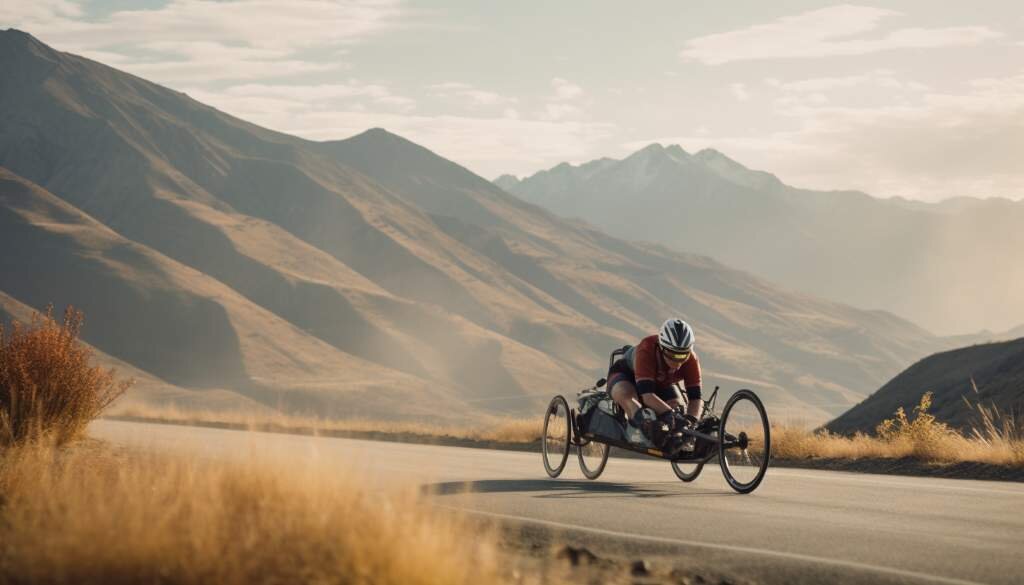
Introduction
Handcycling is a popular form of exercise and recreational activity for individuals with disabilities or mobility impairments. It involves using a specially designed tricycle that is propelled by the arms instead of the legs. Handcycling provides a great upper body workout and offers numerous benefits for both physical and mental well-being.
In this article, we will explore the history, classification, biomechanics, and physiology of handcycling. We will also delve into the benefits of upper body workouts for handcyclists and provide a sample upper body workout routine. By the end of this article, you will have a comprehensive understanding of handcycling and how to design an effective upper body workout for this activity.
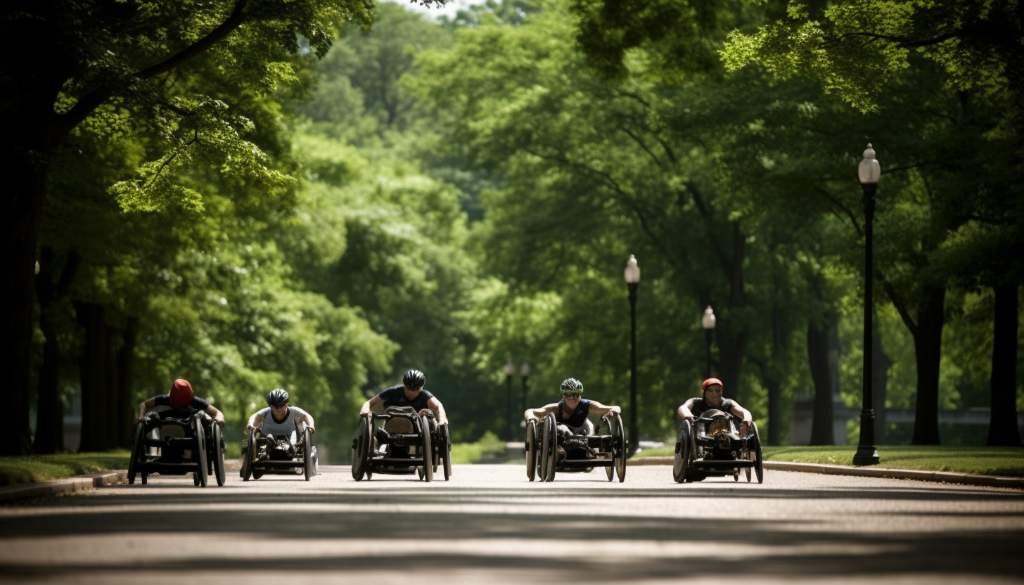
Understanding Handcycling
Handcycling is a unique form of cycling that is specifically designed for individuals with lower limb impairments or disabilities. It involves the use of a special type of bicycle that is powered by the upper body, allowing individuals to propel themselves using their arms and shoulders instead of their legs.
In this section, we will explore the various aspects of handcycling in more detail, starting with a brief history and classification of this sport. We will also delve into the biomechanics and physiology behind handcycling, shedding light on how the body mechanics and physiological demands differ from traditional cycling.
History/Classification of Handcycling
Handcycling, also known as hand cycling or handbike, is a form of cycling that allows individuals with lower limb disabilities to participate in the sport. It provides an excellent cardiovascular workout while utilizing the upper body muscles for propulsion. Understanding the history and classification of handcycling can give us insights into how this sport has evolved over time and the different categories available for athletes.
History of Handcycling:
The origins of handcycling can be traced back to rehabilitation programs for individuals with spinal cord injuries in the 1970s. It was initially developed as a means of therapy and recreation for people with mobility impairments. Handcycles were designed to be manually powered, allowing individuals to experience the joy and freedom of cycling despite their physical limitations.
Over the years, handcycling gained popularity and started to be recognized as a competitive sport. In 1992, handcycling made its debut at the Paralympic Games in Barcelona, paving the way for the inclusion of this sport in international competitions. Today, handcycling has grown into a recognized discipline within the world of adaptive sports.
Classification of Handcycling:
Handcycling is classified into different categories based on the degree of impairment and the specific disability of the athlete. The International Handcycling Federation (UCA) has established classification systems to ensure fair competition. Here are the main categories:
- MH (Men's Handbike): This category is for men with a complete spinal cord injury or similar disabilities. Athletes in this category use their upper body strength to power the handcycle.
- WH (Women's Handbike): This category is for women with a complete spinal cord injury or similar disabilities. Similar to the MH category, athletes in this category rely on their upper body strength for propulsion.
- MH/H1-H4 (Men's Handbike/H1-H4): This category is for men with lower limb impairments, such as amputations or muscle impairments. The H1-H4 subcategories are based on the severity of impairments, with H1 being the most severe and H4 being the least severe.
- WH/H1-H4 (Women's Handbike/H1-H4): This category is for women with lower limb impairments, following the same subcategories as the MH/H1-H4 category.
- MT/T1-T2 (Men's Tricycle/T1-T2): This category is for men with balance impairments or coordination difficulties. Athletes in this category use a tricycle with two rear wheels for stability.
- WT/T1-T2 (Women's Tricycle/T1-T2): This category is for women with balance impairments or coordination difficulties, following the same subcategories as the MT/T1-T2 category.
These classifications ensure that athletes compete against others with similar levels of impairment, creating a fair playing field.
Understanding the history and classification of handcycling is crucial for both athletes and enthusiasts. It highlights the progression of handcycling from a rehabilitation tool to a competitive sport. Additionally, knowing the different categories allows athletes to participate in events that cater to their specific impairments, leading to equal and inclusive competition.
Biomechanics of Handcycling
The biomechanics of hand cycling play a crucial role in understanding the movement and efficiency of this sport. This sub-section will explore the biomechanical aspects involved in hand cycling.
Hand cycling involves using the muscles of the upper body, primarily the arms and shoulders, to propel a specially designed tricycle in a forward motion. The biomechanics of hand cycling are essential to optimize performance and prevent injuries.
One key aspect of the biomechanics of hand cycling is the positioning of the cyclist on the tricycle. The cyclist needs to maintain a low, aerodynamic position to reduce wind resistance and maximize speed. This involves leaning forward, with the hips positioned towards the front of the tricycle and the back straight.
The arm movements in hand cycling are crucial for generating power and propelling the tricycle forward. The biomechanics of the arm movement involve a combination of shoulder flexion and extension, elbow flexion and extension, and wrist movements. These movements need to be coordinated and executed with proper technique to generate maximum force.
Another important aspect of the biomechanics of hand cycling is the grip and hand position. The cyclist needs to have a firm grip on the handles of the tricycle to maintain control and generate power. The hand position should be comfortable and ergonomic to prevent strain and minimize the risk of injury.
Furthermore, the pedaling technique in hand cycling is different from traditional cycling. Hand cyclists use their arms and shoulders to push and pull on the handles in a circular motion, similar to how legs pedal a bicycle. This technique allows for a smooth and efficient transfer of power to the tricycle.
The biomechanical analysis of hand cycling has led to the development of various adaptations and modifications in equipment. For example, the design of the hand cycle itself has evolved to optimize performance and comfort. These modifications include adjustments in the frame geometry, seating position, and handlebar positioning.
Understanding the biomechanics of hand cycling is crucial for enhancing performance and preventing injuries. Coaches, athletes, and sports scientists can use this knowledge to fine-tune technique, improve efficiency, and minimize the risk of overuse injuries.
Physiology of Handcycling
Handcycling is a physically demanding sport that requires a great deal of strength and endurance from the upper body. The physiology of handcycling involves various systems and processes that contribute to the performance and efficiency of hand cyclists. Understanding the physiological aspects of handcycling can help athletes improve their training strategies and optimize their performance.
One important aspect of the physiology of handcycling is the cardiovascular system. During handcycling, the muscles in the upper body work harder and require more oxygen and nutrients to function properly. This increased demand for oxygen is met by an increase in heart rate and blood flow. With regular training and conditioning, hand cyclists can improve their aerobic capacity, allowing them to sustain higher intensities and perform better in races and competitions.
Another key aspect of handcycling physiology is the muscular system. Handcycling primarily engages the muscles of the upper body, including the shoulders, arms, and core. These muscles need to be strong and capable of generating power to propel the handbike forward. Regular resistance training targeting these muscle groups can lead to increased strength and power output, resulting in improved performance on the handbike.
The respiratory system also plays a crucial role in handcycling. As the muscles in the upper body work harder, there is an increased demand for oxygen. The respiratory system adapts by increasing ventilation, allowing for the exchange of oxygen and carbon dioxide. Training the respiratory muscles through specific breathing exercises can enhance the efficiency of oxygen uptake and utilization, leading to improved endurance and performance.
The thermoregulatory system is another important aspect of handcycling physiology. Hand cyclists generate a significant amount of heat during exercise, which needs to be dissipated to prevent overheating. The body regulates its temperature through mechanisms such as sweating and increased blood flow to the skin. It is essential for hand cyclists to stay properly hydrated and manage their body temperature to avoid fatigue and maintain optimal performance on the handbike.
Lastly, the nervous system also plays a role in the physiology of handcycling. Fine motor control and coordination are crucial for maintaining a smooth and efficient cycling motion. Hand cyclists rely on proprioception, the sense of body position and movement, to execute precise movements and maintain balance. By practicing specific drills and exercises that target these neural pathways, hand cyclists can improve their neuromuscular control and enhance their overall performance.
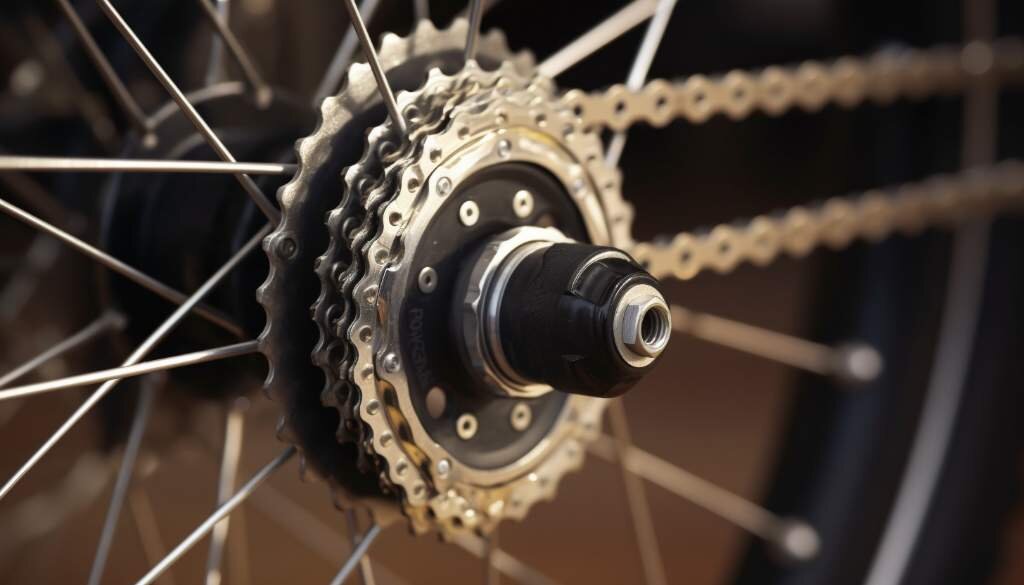
Benefits of Upper Body Workouts for Handcyclists
Handcycling is a form of cycling that allows individuals with physical disabilities to participate in the sport. It involves using the upper body rather than the legs to power the bicycle. This unique activity provides numerous benefits for handcyclists, particularly in terms of upper body workouts.
One of the key advantages of upper body workouts for handcyclists is the development of upper body strength. Handcycling requires a significant amount of strength in the arms, shoulders, and back to propel the bicycle forward. Regular upper body workouts can help build and maintain strength in these areas, allowing handcyclists to improve their performance on the road.
In addition to strength, upper body workouts also enhance endurance. Handcycling can be a demanding activity that requires sustained effort over long distances. By incorporating workouts focused on the upper body, handcyclists can improve their stamina and endurance, allowing them to cycle for longer durations without feeling fatigued.
Furthermore, upper body workouts can help improve posture and stability. The repetitive motion of handcycling can cause imbalances in the muscles, leading to poor posture and stability. By incorporating exercises that target the upper body, handcyclists can strengthen the muscles supporting their spine and improve their overall posture and stability.
Another significant benefit of upper body workouts for handcyclists is injury prevention. Training the muscles in the upper body can help prevent common overuse injuries, such as shoulder impingement or muscle imbalances. Strengthening the muscles surrounding the joints and maintaining flexibility can reduce the risk of injuries and enhance overall physical well-being.
Lastly, upper body workouts have a positive impact on overall fitness levels. Handcycling is a demanding cardiovascular activity, and by focusing on the upper body muscles, handcyclists can boost their cardiovascular fitness. Improved cardiovascular fitness not only benefits handcycling performance but also has positive effects on overall health, including reducing the risk of cardiovascular diseases.
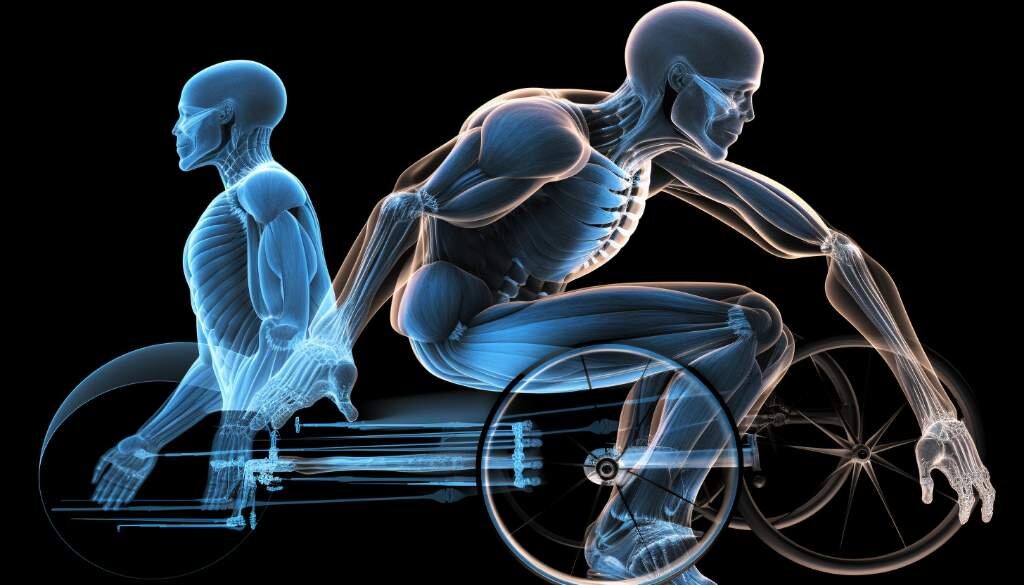
Designing an Effective Upper Body Workout
Designing an effective upper body workout is essential for handcyclists to improve their strength, power, and endurance. This specialized workout is specifically tailored to target the upper body muscles that are used during handcycling, helping handcyclists optimize their performance on the track or road.
In this section, we will explore various aspects of designing an effective upper body workout for handcyclists. We will delve into exercise selection, resistance training techniques, and high-intensity interval training (HIIT) methods that are specifically beneficial for handcyclists. By implementing these strategies, handcyclists can maximize their upper body strength and endurance, resulting in enhanced performance and overall fitness.
Exercise Selection
When designing an effective upper body workout for handcyclists, it is important to select exercises that target the major muscle groups used in hand cycling and improve overall strength and endurance. Here are some key considerations for exercise selection:
- Shoulder Exercises: Handcycling predominantly involves the use of the shoulders, so it is crucial to include exercises that strengthen the muscles surrounding the shoulder joint. Examples of effective shoulder exercises include shoulder presses, lateral raises, front raises, and bent-over rows.
- Arm Exercises: The muscles of the arms, including the biceps and triceps, play an essential role in generating power and controlling the movement of the handcycling motion. Exercises such as bicep curls, tricep dips, and push-ups are effective in targeting these muscles.
- Core Exercises: Developing a strong core is vital for maintaining stability and transferring power between the upper body and the bike. Exercises like planks, Russian twists, and seated medicine ball twists help strengthen the core muscles.
- Back Exercises: The muscles of the back, including the latissimus dorsi and the rhomboids, are involved in the pulling phase of handcycling. Incorporating exercises like lat pulldowns, seated rows, and reverse flyes helps to strengthen these muscles.
- Endurance Exercises: In addition to strength training exercises, it is also important to include endurance exercises to improve the overall stamina and endurance of the upper body. This can be achieved through activities such as swimming, rowing, or using a hand ergometer.
By incorporating a variety of exercises that target the different muscle groups involved in hand cycling, handcyclists can develop a well-rounded upper body workout that enhances their performance and reduces the risk of injury.
Resistance Training Techniques for Handcycling
Resistance training is an essential component of an effective upper body workout routine for handcycling. It helps build strength, endurance, and power in the upper body muscles, which are crucial for maintaining proper cycling form and generating force on the hand pedals. In this sub-section, we will explore some key resistance training techniques that can benefit handcyclists.
1. Free Weights:
Using free weights such as dumbbells, kettlebells, or barbells is an excellent way to target specific muscle groups used in handcycling. Exercises like bicep curls, tricep extensions, shoulder presses, and chest presses can help isolate and strengthen the muscles in your arms, shoulders, and chest. Start with lighter weights and gradually increase the resistance as you get stronger.
2. Resistance Bands:
Resistance bands are a versatile and portable training tool that can be used to mimic the resistance offered by hand pedals. They allow for a wide range of exercises, including rows, curls, chest flies, and shoulder rotations. Resistance bands come in different strengths, so you can easily adjust the intensity of your workout by using bands with higher or lower resistance.
3. Machine-Based Exercises:
Gym machines are another effective option for resistance training. Cable machines, chest presses, lat pulldowns, and rowing machines can help target multiple muscle groups simultaneously and allow for controlled and safe movements. Make sure to adjust the machines to fit your body size and position yourself correctly to maintain proper form.
4. Circuit Training:
Circuit training involves performing a series of exercises back-to-back with minimal rest. This training method helps improve muscular endurance and cardiovascular fitness. Create a circuit that includes exercises like push-ups, pull-ups, dips, and shoulder presses. Perform each exercise for a set amount of time or repetitions before moving on to the next one.
5. Isometric Exercises:
Isometric exercises involve static contractions of the muscles without any joint movement. Wall sits, planks, and static push or pull exercises can be beneficial for handcyclists. Isometric exercises help develop stability and strengthen the muscles while minimizing joint stress.
6. Core and Stability Training:
A strong core is vital for maintaining proper posture and balance during handcycling. Incorporate exercises like plank variations, Russian twists, and stability ball exercises to target your core muscles. These exercises will not only improve your performance but also reduce the risk of injuries.
Remember to warm up before starting your resistance training session and cool down afterward. Start with lighter weights or resistance levels and focus on maintaining proper form throughout each exercise to maximize the benefits and prevent injuries.
High-Intensity Interval Training (HIIT) for Handcycling
High-Intensity Interval Training (HIIT) is a popular workout technique that can be highly effective for handcyclists looking to improve their upper body strength and endurance. HIIT involves alternating between short bursts of intense exercise and brief recovery periods. This type of training is known to provide numerous benefits for athletes, including increased cardiovascular fitness, improved muscular strength, and enhanced overall athletic performance.
When it comes to handcyclists, HIIT can be particularly beneficial for several reasons. Firstly, it allows for a more efficient use of training time. HIIT workouts typically last for a shorter duration compared to traditional steady-state cardio exercises, yet they provide similar or even greater benefits in terms of cardiovascular conditioning. This is especially advantageous for handcyclists who may have limited time for training but still want to maximize their workout results.
In addition to time efficiency, HIIT workouts can also help handcyclists improve their anaerobic capacity. Handcycling itself is an activity that primarily relies on the upper body's aerobic energy system. However, incorporating HIIT into the training routine can stimulate the anaerobic system, leading to enhancements in power, speed, and overall performance. This can be particularly beneficial for handcyclists who partake in races or competitive events where short bursts of high-intensity effort are required.
When designing a HIIT workout for handcyclists, it is essential to consider the specific needs and abilities of the individual. The intervals should be tailored to match the athlete's current fitness level, gradually progressing in intensity and duration over time. It is also important to ensure proper warm-up and cool-down periods to prevent injuries and optimize recovery.
Some examples of HIIT exercises that can be incorporated into a handcyclist's workout routine include:
- Sprints: Perform short and intense bursts of maximal effort handcycling for a specific distance or duration, followed by a short rest period.
- Chest Press Intervals: Use resistance bands or weights to perform chest presses at a high intensity for a set number of reps, followed by a brief rest.
- Shoulder Circuit: Alternate between different shoulder exercises such as lateral raises, front raises, and overhead presses, focusing on quality and intensity.
Remember to consult with a qualified fitness professional or coach for personalized advice and guidance when incorporating HIIT into your handcycling training program.
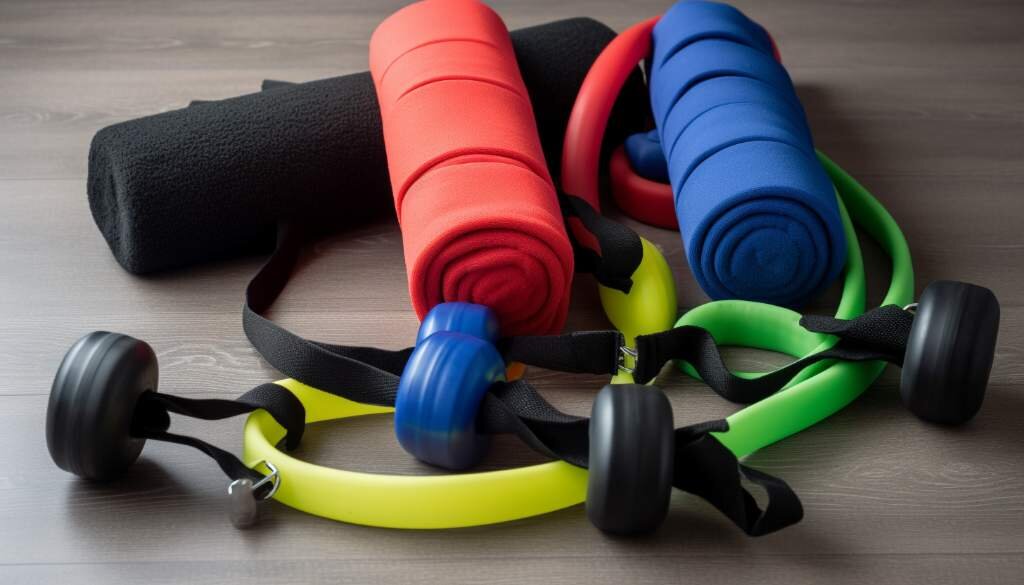
Sample Upper Body Workout Routine
When designing an effective upper body workout routine for handcyclists, it is important to focus on exercises that target the muscles used during cycling. These exercises should improve strength, endurance, and flexibility, while also preventing injury.
Here is a sample upper body workout routine for handcyclists:
- Warm-up: Start with 5-10 minutes of light cardio, such as arm circles or shoulder rolls, to warm up the upper body muscles.
- Resistance Training: Perform exercises that target the major upper body muscles used in hand cycling, such as the shoulders, arms, and core. Examples include bicep curls, overhead presses, lateral raises, tricep dips, and planks.
- High-Intensity Interval Training (HIIT): Incorporate HIIT exercises into the routine to improve cardiovascular fitness and simulate the intensity of hand cycling. For example, alternate between 30 seconds of maximum effort arm cycling and 30 seconds of rest for 10 rounds.
- Cool-down: Finish the workout with 5-10 minutes of stretching exercises for the upper body muscles, such as arm and shoulder stretches.
Remember to adjust the intensity and duration of each exercise based on your skill level and fitness goals. It is also recommended to consult with a certified fitness professional to ensure proper form and technique.








